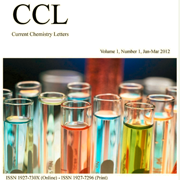 |
1.  |
Quantum chemical study of reaction mechanism of [4+2]-cycloaddition between 2,3-dimethylbuta-1,3-diene and methyl acrylate
, Pages: 1-6 Yaroslav Kovalskyi, Olga Marshalok, Natalia Vytrykush and Halyna Marshalok |
||
|
Abstract: The quantum-chemical modeling mechanism of the [4+2]-cycloaddition reaction of 2,3 dimethylbuta-1,3-diene and methyl acrylate was conducted. Its qualitative aspects were analyzed at the molecular level by the program MOPAC2012 and semiempirical method RM1. The potential energy surfaces of 2,3 dimethylbuta-1,3-diene and methyl acrylate [4+2] cycloaddition possible reaction pathways were constructed by restricted and unrestricted Hartree-Fock approximation. It has been established that the molecule of the final product methyl-3,4-dimethylcyclohex-3-encarboxylate has the half-chair shape, wherein the carboalkoxyl group is in the exo-orientation. Interaction between molecules of 2,3 dimethylbuta-1,3-diene and methyl acrylate occurs by a two-step mechanism more likely than one-step, since the activation parameters of this interaction maximum coincide with the experimental data. DOI: 10.5267/j.ccl.2016.11.003 Keywords: Mechanism, [4+2]-cycloaddition, 2,3-Dimethylbuta-1,3-diene, Methyl acrylate
|
|||
2.  |
Synthesis of allyl-glycidyl ether by the epoxidation of diallyl ether with t-butyl hydroperoxide over the Ti-MWW catalyst
, Pages: 7-14 Agnieszka Wróblewska, Marika Walasek and Beata Michalkiewicz |
||
|
Abstract: In this paper, modified hydrothermal method for Ti-MWW catalyst preparation has been shown. Instrumental analysis of the zeolite material Ti-MWW has been performed by means of UV-vis spectrometry, infrared spectrometry (IR), scanning electron microscope (SEM), X-ray diffraction (XRD), and X-ray microanalysis. Moreover, the results of the epoxidation of diallyl ether (DAE) over the titanium silicate catalyst Ti-MWW and in the presence of methanol have been presented. t-Butyl hydroperoxide have been applied for the first time as an oxidant for this process. The influence of temperature (20-130°C), DAE/TBHP molar ratio (1:1-3:1), methanol concentration (10-80 wt%), amount of catalyst (1-7 wt%) and reaction time (60-1440 min.) was studied. The main functions describing the process were determined on the basis of the results obtained from the gas chromatography method. DOI: 10.5267/j.ccl.2016.11.002 Keywords: Diallyl ether, Allyl-glycidyl ether, Ti-MWW, t-Butyl hydroperoxide, Epoxidation
|
|||
3.  |
DFT study of the decomposition reactions of nitroethyl benzoates catalyzed by the 1,3-dimethylimidazolium cation
, Pages: 15-22 Agnieszka Kącka and Radomir Jasiński |
||
|
Abstract: DFT calculations indicate that the decomposition reaction of nitroethyl benzoates in the presence of 1,3-dimethylimidazolium cation takes place much faster than in the case of the non-catalyzed process. Additionally, our calculations suggest one-step polar mechanism of title reactions. DOI: 10.5267/j.ccl.2016.11.001 Keywords: Thermal elimination, Quantum chemical study, Nitroalkenes
|
|||
4.  |
Synthesis and characterization of nano-structured perovskite type neodymium orthoferrite NdFeO3
, Pages: 23-30 Mostafa Yousefi, Samaneh Soradi Zeid and Mozhgan Khorasani-Motlagh |
||
|
Abstract: In this investigation, neodymium orthoferrite (NdFeO3) nanoparticles has been synthesized through ultrasonic method in the presence of octanoic acid as surfactant. This method comparing to the other methods is very fast and it does not need high temperatures during the reaction. The spherical NdFeO3 nanoparticles with an average particles size of about 40 nm can be obtained at a relatively high calcination temperature of 800 °C for 4 h. Also, product obtained by this method are uniform in both morphology and particles size. The phase composition, morphology, lattice parameters and size of particles in these product are characterized by Fourier transform infrared (FT-IR) spectroscopy, X-ray diffraction (XRD) scanning electron microscopy (SEM) and energy dispersive X-ray spectrometer (EDX). The XRD analysis reveals only the pattern corresponding to perovskite type NdFeO3 which crystallizes in the orthorhombic structure. Energy dispersive X-ray analysis confirms the elemental compositions of the synthesized material. DOI: 10.5267/j.ccl.2016.10.002 Keywords: Nanoparticles, Ultrasonic irradiation, Octanoic acid, Perovskite, NdFeO3
|
|||
5.  |
Design and synthesis of benzyl 4-O-lauroyl-α-L-rhamnopyranoside derivatives as antimicrobial agents
, Pages: 31-40 Mohammed M. Matin, Mohammad M.H. Bhuiyan, Abul K.M.S. Azad and Nishat Akther |
||
|
Abstract: Benzyl α-L-rhamnopyranoside, prepared by both conventional and microwave assisted glycosidation techniques, was converted into benzyl 2,3-O-isopropylidene-α-L-rhamnopyranoside which after lauroylation followed by removal of isopropylidene group gave the benzyl 4-O-lauroyl-α-L-rhamnopyranoside in good yield. Several derivatives of benzyl 4-O-lauroyl-α-L-rhamnopyranoside were prepared and assessed in vitro for their antimicrobial activity against ten human pathogenic bacteria and seven fungi. The structure activity relationship (SAR) study revealed that incorporation of 4-O-lauroyl group in rhamnopyranoside frame work along with 2,3-di-O-acyl group increased the antifungal potentiality of the rhamnopyranosides. DOI: 10.5267/j.ccl.2016.10.001 Keywords: Benzyl α-L-rhamnopyranoside, Lauroylation, Antimicrobial agents, Structure activity relationship (SAR)
|
|||